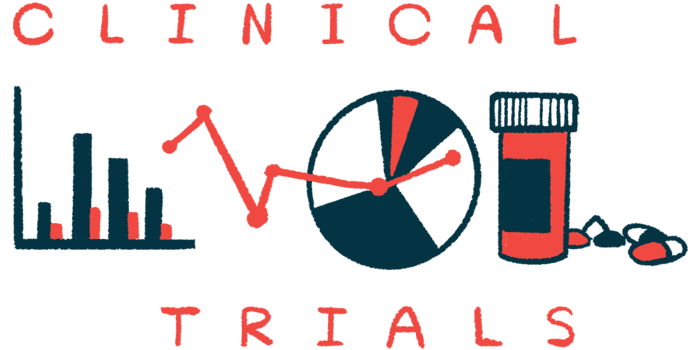BBP-418 improves walking ability in LGMD2i patients in Phase 3 trial
Developer 'to move swiftly' in seeking therapy's approval by FDA

Use of the oral therapy BBP-418 appeared to improve walking ability and lung function in people with limb-girdle muscular dystrophy type 2i (LGMD2i) — characterized by muscle wasting at the shoulders and the hips — in a Phase 3 clinical trial, according to new interim data announced by developer Bridgebio Pharma.
The experimental therapy was also found to reduce a key marker of muscle damage by more than 80%.
Per the new interim analysis, the trial hit all of its primary and secondary goals, Bridgebio said. The company is now planning to engage with the U.S. Food and Drug Administration (FDA) in hopes of submitting an application for approval of BBP-418 next year for LGMD2i, also called LGMDR9.
“For individuals living with LGMD2I/R9, a condition that slowly takes away the strength, breathing, and independence of an individual, each day matters,” Douglas Sproule, MD, chief medical officer of ML Bio Solutions, a Bridgebio company developing BBP-418, said in a company press release.
“We are determined to move swiftly toward filing for approval, so that BBP-418, if approved, can become the first therapy to change the course of this devastating disease,” Sproule said.
Dan Pope, who lives with LGMD2i and is vice president and advocacy director of the CureLGMD2i Foundation, noted that “living with LGMD2I/R9 is a daily negotiation with limits, and I won’t pretend it’s easy.”
Pope expressed optimism about the trial results.
“I’m fiercely independent, but I’m not alone — our community lifts me,” Pope said. “It finally feels like science is catching up to our hope, so we can look ahead with real possibility.”
FORTIFY trial tested BBP-418 against a placebo for LGMD2i
LGMD2i or LGMDR9 is caused by mutations in the gene that encodes the enzyme FKRP. This enzyme is needed for glycosylation, a biochemical process in which sugar molecules are attached to proteins. In people with LGMD2i, a muscle protein called alpha-dystroglycan cannot be glycosylated properly. As a result, it doesn’t work correctly, so muscles accumulate damage over time, especially in the hips and shoulders.
BBP-418 is designed to increase alpha-dystroglycan glycosylation by providing the body with more raw materials to add these special sugar molecules to the protein. The new interim analysis comes from the Phase 3 FORTIFY trial (NCT05775848), which is testing the therapy against a placebo in adults and adolescents with LGMD2i.
The main goal of this interim analysis was to determine if the therapy was increasing alpha-dystroglycan glycosylation as designed. The results showed that, after three months of treatment with BBP-418, alpha-dystroglycan glycosylation levels nearly doubled, to about 17% of what’s seen in people without LGMD2i. This was sustained for a year on BBP-418, according to Bridgebio. Meanwhile, the company said that alpha-dystroglycan glycosylation showed “approximately no change” in patients given the placebo.
Increases in alpha-dystroglycan glycosylation with BBP-418 were seen in patients with all types of FKRP gene mutations. The therapy also led to an 82% decrease in levels of creatine kinase, a marker of muscle damage.
Available one-year data also indicated that BBP-418 improved lung function and walking ability. Specifically, in a test where participants were timed while they walked 100 meters (about 328 feet), patients given BBP-418 walked faster, by an average of 0.14 m/s, after a year of therapy. By contrast, patients given the placebo became slower over time, for a between-group difference of 0.27 m/s.
I’m very excited to see that treatment with BBP-418 was associated with clinically meaningful improvements in motor and pulmonary function. … These results bring enormous hope that BBP-418 might change the disease course.
The same trends were seen in forced vital capacity, a marker of lung function based on how much air someone can blow out in a forceful breath. Average predicted FVC improved by about 3% in patients given BBP-418 and decreased in the placebo group, for a between-group difference of about 5% on average.
“I’m very excited to see that treatment with BBP-418 was associated with clinically meaningful improvements in motor and pulmonary function, along with robust restoration of [alpha-dystroglycan] glycosylation,” said Katherine Mathews, MD, a professor at the University of Iowa. “This is such an important result for individuals living with LGMD2I/R9, which is a progressive muscular dystrophy. The resulting weakness often leads loss of ambulation, need for respiratory support, and need for heart failure medications.”
Mathews noted that, “to date, there has been no specific treatment [for LGMD2i]. These results bring enormous hope that BBP-418 might change the disease course.”
No unexpected safety issues seen with therapy in ongoing trial
Bridgebio also reported that BBP-418 was overall tolerated well, and no unexpected safety issues have been seen in the Phase 3 trial. The study is ongoing at 20 locations in the U.S. and Europe, and one in Australia.
Sproule expressed appreciation for all those involved in the trial.
“Our heartfelt thanks go out to the individuals in our study, their caregivers, investigators, and study staff who have actively participated in FORTIFY and continue to contribute to this pivotal research. The FORTIFY results reaffirm the power of targeting this genetic disease at its source with relentless focus and compassion,” Sproule said.







